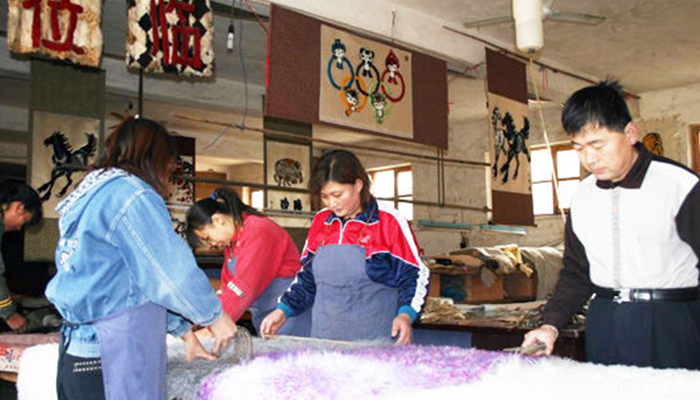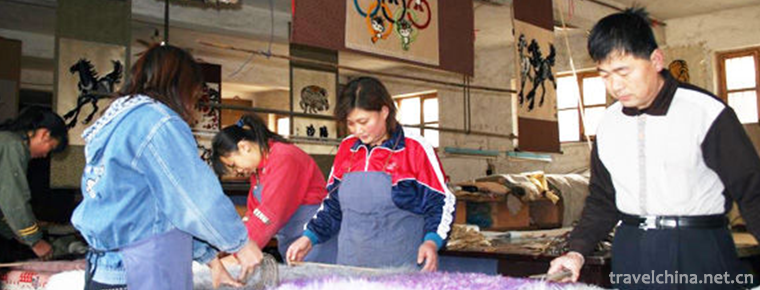Tanning Technology of Tan Sheepskin
Tanning Technology of Tan Sheepskin
Tanning technology of Tan sheepskin, a traditional handicraft in Jiaocheng County, Shanxi Province, is one of the national intangible cultural heritages.
Tanning process of Tan sheepskin in Jiaocheng County is relatively complex, totally depending on manual operation. There are more than 20 processes such as washing, soaking, drying, shoveling, nailing, tanning, hanging, pressing, cutting, sewing and so on. In the tanning process, it is necessary to add some auxiliary materials such as yellow surimi (grain similar to millet), leather nitrate, soap horn and so on, and finally produce Tan sheepskin finished products.
On June 7, 2008, Tansheepskin tanning technology was approved by the State Council of the People's Republic of China and listed in the second batch of national intangible cultural heritage list, item number_-111.
historical origin
The tanning technology of Jiaochengtan sheepskin originated in the mid-Ming Dynasty and lasted for more than 400 years. "China Industrial Chronicle" once described Jiaocheng fur industry: "Shanxi is famous for sheep herding, and the tannery industry developed with it. In the late Ming and early Qing dynasties, there were already tanneries in Datong and Jiaocheng. "Jiaocheng leather goods with beach skin as the most famous, exquisite manufacturing..." Jiaocheng fur industry reached its peak in Ming and Qing dynasties.
According to the records, there were still more than one hundred Pifangs in Jiaocheng in the late Qing Dynasty and the early Republic of China, with an annual total output value of more than 3.1 million silver dollars. At that time, there were more than 10,000 workers working in Pifang. Among these people, only 2,000 people lived permanently in Jiaocheng City, and more than 9,000 were migrant workers.
In 1933, the Ministry of Education of Nanjing National Government published a "Overview of the Latest China Situation" which introduced Jiaocheng as follows: "Turen are good at making cattle and sheep skins, Jiaochengtan sheep skins are well-known throughout the country."
After the outbreak of the War of Resistance Against Japan, the fur industry in Jiaocheng shrank rapidly. Traffic interruption led to the passivity of raw fur and the lack of access to products. In addition, the products plundered by the aggressors resulted in the bankruptcy of fur shops, leather stores and related financial and service industries. A large number of workers lost their jobs and went to Zhangjiakou and Taiyuan to make a living. After the founding of New China, Jiaocheng fur industry once recovered. First, "Heji" fur shop was opened and small batch production was carried out.
After the founding of New China, a "local state-owned Jiaocheng fur factory" was established. The tanning technology of Jiaochengtan sheepskin was inherited. It went bankrupt in the 1980s, and the tanning technology of Jiaochengtan sheepskin was in danger of being lost.
Technological characteristics
Tanning of Tan sheep leather is the chemical and physical processing of protein in the skin with tannin. Through a series of tanning processes and some chemicals, a series of changes in the protein in animal skins, such as cattle, pigs and sheep, have resulted in the denaturation of collagen. Tanned leather is soft, firm and wear-resistant, and it is not easy to spoil and deteriorate. Therefore, tanned leather can be used to make various kinds of leather articles for daily use.
Jiaocheng "Tansheepskin" treated by tanning process of Tansheepskin has fine and soft wool, white as snow, luster as jade, long hair edge and wavy bending, some up to nine lines. A gentle tremor is like a willow in the wind and a ripple wave. Beach wool fiber is slender and even, soft and fluffy, elastic, but also the production of blankets, shawls, necks, sweaters and other high-grade raw materials.
Technological process
Tanning process of Tan sheepskin is relatively complex, totally depending on manual operation, including washing, soaking, drying, shoveling, nailing, tanning, hanging, pressing, tailoring, sewing and other 20 processes, resulting in the final production of Tan sheepskin products. The following is the tanning process of Tan sheepskin.
(1) Skin cleaning and dirt removal, apprenticeship, small-scale work, iron grate combing, removal of soil and feces, scraper oil, etc.
(2) Skin washing, also known as stepping on skin, dirty heavy work, in the field wells near the water intake and drainage convenience of brick pond, soak foot washing stepping on. In March and April of the lunar calendar, the water is cold and piercing. Breakfast is served with wine, yam vermicelli and cold dishes.
People are susceptible to varicose veins, arthritis and other diseases.
(3) soak the skin, add leather nitrate, yellow rice flour, yellow porridge into the vat, soak for more than one month;
(4) Cleaning and scrubbing;
(5) Blasting and drying in sandy sites;
(6) Skin shoveling, mechanic work, using special tools to shovel the bell and thin skin plate;
(7) hanging and drying;
(8) Distribution, technicians, judgement of fineness, sorting and grading;
(9) In case of laying down a case, technicians work and cut in large quantities, except for the tail corner of the leg;
(10) Inspection;
(11) Nail plate, mechanic work, stretching nail exhibition;
(12) Tanning, hand rubbing;
(13) Repairing defects and skilled work;
(14) Seam-bearing, mechanic work, collocation and combination;
(15) Face and clean up the dust;
(16) hanging washing, washing with clean water and combing curls;
(17) Press the plate and press it flat for several days.
(18) Re-hanging and washing;
(19) Cutting and shaping, skilled work;
(20) Fine hand-sewn ready-made clothes, usually sewed by housewives with their families;
(21) Packaging, according to the requirements of the post office in the Republic of China, five or six pieces in a package, with oilpaper for internal use and cloth for external use, with a neat and uniform shape, weighing about 15 kilograms per package.
Inheritance and Protection
Inheritance value
The winter clothes made of Tan sheepskin for men and women are soft and warm, beautiful and generous, and have good decorative effect. Jiaocheng Tan Sheepskin is famous all over the world for its excellent quality and unique style. In European and American markets, women's winter fashion often uses fur, graceful and luxurious, very fashionable.
Current situation of inheritance
After the founding of New China, Jiaocheng County established a "local state-owned Jiaocheng fur factory", and the tanning process of Jiaochengtan sheep was inherited. However, the factory went bankrupt in the 1980s because of poor management. The age of the old skinners in Jiaochengtan sheepskin was aging. There were few successors and the technology was on the verge of being lost.
Heritage figures
Zhang Xiaochun, male, Han nationality. On May 8, 2018, Zhang Xiaochun was selected as the representative successor of the fifth batch of national intangible cultural heritage projects. Jiaocheng County, Shanxi Province, declared the project: Tansheepskin tanning process.
protective measures
In 1958, the fur production cooperative upgraded and established a local state-owned Jiaocheng fur factory, and the tanning process of Jiaochengtan sheepskin was inherited.
social influence
Important activities
In August 2016, Jiaocheng County held the "Wonderful Jiaocheng" National Fitness Week and Cultural Exhibition Week, inviting representative inheritors, including Jiaochengtan sheepskin, to show their skills on the spot, and to carry out teaching activities on the spot to disseminate Chinese traditional culture.
In June 2017, Lvliang City celebrated the first National Day of Cultural and Natural Heritage, organizing non-hereditary successors, including the tanning process of Jiaochengtan sheepskin, to show the physical and physical production process of Lvliang City's non-heritage protection project, which was praised by the masses.
In October 2017, the Cultural Bureau of Jiaocheng County organized the non-hereditary inheritance and experience activities. Through on-site exhibition of the production techniques of Tan sheepskin, glazed glaze, pyrography, paper-cut and so on, the non-heritage cultural inheritors made many participants deeply understand the traditional handicraft of Jiaocheng County.
Honorary recognition
In 1980, Jiaocheng Tanned Tan Sheepskin was appraised as a kind of product at the national wool quality appraisal meeting, and was awarded the title of "Shanxi Province's high quality product".


-
1.Letinous edodes chicken Noodles
Letinous edodes stewed chicken originated in Northern Jiangsu
Time 2018-10-12 -
2.Beigushan HillBeigu Mountain
Beigu Mountain, one of the three scenic spots in Zhenjiang, overlooks Beigu, pillows the river, rocky walls, and the mountain is dangerous, so it is named Beigu Mountain
Time 2018-12-06 -
3.Water Margin City Scenic Area of the Three Kingdoms
The Wuxi Film and Television Base of CCTV is the first large-scale film and television shooting and tourism base in China. Founded in 1987, it is the first theme park in China that combines film and t
Time 2018-12-18 -
4.the Capital Cities and Tombs of the Ancient Gaogouli Kingdom
Gaogouli is located in Ji'an City, Jilin Province. It includes domestic cities, Wandu Mountain City, 14 Royal mausoleums and 26 noble tombs. Domestic city and Wandu Mountain City
Time 2019-01-12 -
5.Eight treasures taro
Babao taro paste is one of the local traditional sweet spots in Fujian cuisine. This dish is delicate, soft, sweet and delicious. It looks like a cold dish but burns its mouth. It has a unique flavor.
Time 2019-03-27 -
6.Oroqen Folk Songs
The Oroqen nationality mainly distributes in the Oroqen Autonomous Banner, Buteha Banner of Hulunbeier League, Inner Mongolia Autonomous Region and
Time 2019-04-28 -
7.Grass grass drums and drums
Grass gongs and drums, also known as grass chants, are commonly known as "hilarious songs". It is a unique form of folk song art. It is a kind of Tujia folk song that the
Time 2019-05-02 -
8.Liaoning wind and percussion ensemble
Liaoning drum music, commonly known as drum music. It is one of the traditional folk instrumental music in China. Liaoning drum music is divided into Suona music and Sheng wind music, and according to
Time 2019-05-13 -
9.Southwest Petroleum University
Southwest Petroleum University is a petroleum undergraduate college founded in the face of the new China's Chaoyang. It is a co-established University between the central and local governments, mainly
Time 2019-08-31 -
10.Jintang Yunding mountain scenic spot
Jintang Yunding mountain is located in the middle section of Longquan Mountain in Jintang County, Chengdu. The scenic spots include Yunding mountain, Hantan ancient ferry, Jintang small Three Gorges of Tuojiang River
Time 2020-11-05 -
11.The second industry of Panzhihua
In 2018, the total industrial added value of Panzhihua was 69.163 billion yuan, an increase of 7.0%, and its contribution rate to economic growth was 59.7%. At the end of the year, there were 325 Industrial Enterprises above designated size. The production and sales rate
Time 2020-12-14 -
12.Deyang Sports
In 2017, Deyang City built 791 national fitness routes and 608 national fitness projects. At the end of the year, there were 10 public stadiums and stadiums, and the annual sales of sports lottery tickets were 160 million yuan.
Time 2020-12-14